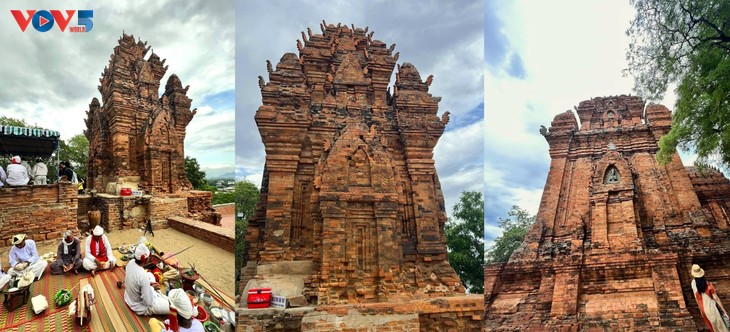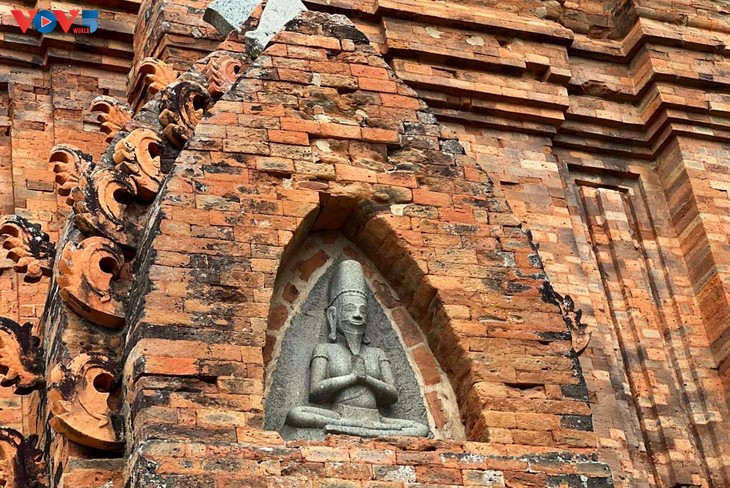On Vietnam’s south-central coast, ancient Cham towers stand the test of time, witnessing the whispers of the wind. Since July 1, when Ninh Thuan and Khanh Hoa province merged into one, visitors can now explore a heritage route linking the Po Nagar Tower in Nha Trang with the Po Klong Garai tower complex in Phan Rang, offering a journey into Champa culture, once a flourishing civilization in central Vietnam.

Po Klong Garai tower cluster in Phan Rang-Thap Cham city (photo: The Hung/ VOV)
On Trau Hill, in Phan Rang-Thap Cham city, the Po Klong Garai tower cluster comes alive when there is a prayer session to worship for favorable weather. This major traditional ritual of the Cham is held at the beginning of the dry season. Hundreds of locals, dressed in traditional Cham costumes, gather at the foot of the towers to offer incense and prayers to the accompaniment of music of drums and flutes, creating a sacred atmosphere.
Paseh Man, a Cham clergyman, said: “This ceremony is to pray for favorable weather and abundant harvests. It’s dedicated to the King of the Cham, who was the founder of this region. We, the Cham descendants, must worship him annually. The King left us with these towers, so we pay tribute to him here.”

Duong Gian Sat ceremony of the Cham to pray for favorable weather (photo: The Hung/ VOV)
Po Klong Garai towers were built in the 13thto 14thcentury to honor King Po Klong Garai, a talented ruler who built dams, brought water to the fields, and saved the people from drought. The complex of three structures, the main tower, fire tower, and gate tower, are a vivid testament to Cham construction techniques of bricks without mortar and exquisite carvings telling stories of mythology and daily life. Amid the harsh sun and wind, the red bricks glow brightly for hundreds of years.
For the Cham people, these ancient towers are sacred places of worship and the pride of the Champa kingdom full of mysteries.
Leaving Phan Rang and travelling along the coastal highway, visitors arrive in Nha Trang, where the majestic Po Nagar Tower stands by the Cai River. Built between the 8th and13thcenturies, the complex is dedicated to Goddess Po Nagar (Mother of the Land), who, according to legend, taught people doing farm work, weaving, and protecting the homeland. This spiritual center attracts hundreds of thousands of visitors each year.

The Cham build the temples with baked bricks, decorated with stones, but without using adhesives. (photo: The Hung/ VOV)
The Cham built temples to worship kings, deities, the Mother Goddess, and the supreme Hindu gods. By the 17thcentury, this site was preserved by the Vietnamese. It became a place worship for the Cham Goddess Po Nagar and the Vietnamese Holy Mother Thiên Y A Na. That’s why the site has two names: Po Nagar Tower and Thiên Y Holy Mother Tower. The Cham built the temple with baked bricks, decorated with stones, but without using adhesives.
So how can the bricks remain bonded and last until today? We don’t see any adhesive between the bricks. The secret has yet to be uncovered. The tour guide’s narration gives us a glimpse into the extraordinary history and architecture of the ancient Cham people.
Tourist Nguyen Van Luat, from Ho Chi Minh City, said: “The architecture is unique and remarkable. It’s amazing to build such towers from bricks without any visible adhesive. It cannot be mistaken for any other architectural style.”

Ancient Cham towers stand the test of time (photo: The Hung/ VOV)
From the tower’s courtyard, Nha Trang city stretches out with bridges across the river, turquoise beaches, and islands scattered offshore. During the Po Nagar Tower Festival, tourists are entertained with graceful folk dances and joyful Paranung drum beats.
The journey from Po Nagar Tower to Po Klong Garai offers tourists a deeper understanding of the Cham’s festive rituals in Nha Trang, to their irrigation legends to survive in the sunny, windy Phan Rang region. This is a chance for visitors to explore deeply a once-glorious Southeast Asian civilization and be well-aware of heritage promotion and preservation.
The Hung